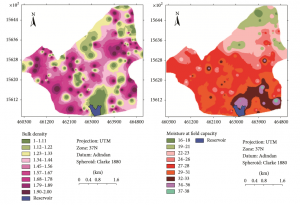I chose the article “Soil Erosion Prediction Using Morgan-Morgan-Finney Model in a GIS Environment in Northern Ethiopia Catchment”, authored by Gebreyesus Brhane Tesfahunegn, Lulseged Tamene, and Paul L. G. Vlek and publishe din the Applied and Environmental Soil Science journal in April 2014.
This study designated a catchment area in Ethiopia that has historically been poorly managed and is heavily relied upon for agricultural purposes. Former studies have only used point observation data such as runoff plots which is inadequate to assess the spatial distribution of ecological problems.
The researchers chose the MMF model due to its simplicity and flexibility. Other process-based models require large amounts of information which is not available for developing regions such as this one. They incorporated a multitude of hydrophysical parameters that influence erosion rate which include both natural and man-made features.
The goal of the study was to create spatial maps that could be interpreted for prioritizing areas within the catchment that require immediate management measures. Data was collected for rainfall, land use, digital elevation model, soil texture, soil moisture content, soil detachability, bulk density of soil, cohesion of soil surface, hydrological top soil depth, and ratio of actual to potential evapotranspiration.
The model predicted higher soil loss rates than the maximum tolerable soil loss rate and was able to designate hotspots that were most eroded with low soil quality and overgrazed due to poor land management practices. This study demonstrated the importance that GIS can bring for analyzing spatially distributed hydrophysical data to assess the effects and distribution of erosion. The following figures show the maps that were created of the catchment area using the MMF model:



